Creating a website for your business is daunting, especially if your company is large or you’re creating an e-commerce website. Ideally, your business website should be easy for Google rank, easy for visitors to use, and easy to update. And it can be – you just have to plan for it. This article will show you how.

Creating a Website for Your Business: SITEMAP
The first step to creating a website for your business is to create a sitemap. A sitemap is exactly what it sounds like it is: A map of your website. This map is used by search engines like Google and website visitors. Both use the sitemap for the same thing: to find pages.
It’s necessary that Google finds the pages on your website, so that it can crawl, index, and rank those pages. It’s also necessary for your customers (clients/target audience) to find them, so they can quickly and easily discover your business offerings.
Your Sitemap Starts as an Outline
Google is really just a huge, digital library.
Like a library, Google is organized a lot like books are organized in a library. (Keep that in mind during the entire process of creating a website for your business.)
When you determine the pages on your website, think of an outline for a paper – but the topic is your business.
First, write a quick summary of your business.
Next, create an outline based on the services or products offered by your business.
Here’s an example:
Artonic is a Michigan Web Design agency. We offer website design, development, support, marketing, advertising, and branding. We are a team of experts with a brick-and-mortar location in Michigan.
Our website outline looks like this:
HOME
SERVICES
- Digital Marketing
- Advertising (AdWords)
- Website Support
- Branding
- Photos / Videos
STORIES
ABOUT
CONTACT
Now, let’s create a sitemap for your business.
Creating a Sitemap for Your B2B Business
When you create an outline for your business, you’ll likely want to include these three pages, no matter what your size:
Home
About Us
Contact Us
These three pages are necessary on most websites, from small business to large corporations. This isn’t just “an industry standard” – these pages are included on websites because your target audience expects and wants them on your business website. Your target audience is the group of people for whom you’re creating a website for your business in the first place – so include the pages they want.
Next, add a page for Services or Products or both. So far, here’s your outline:
HOME
SERVICES
ABOUT
CONTACT
This is only the beginning – Let’s continue to build the outline for your business. Under Services, list the services you provide in a bulleted list.
HOME
SERVICES
- Service 1
- Service 2
- Service 3
ABOUT
CONTACT
Have a lot of items listed under Services? That’s okay. Go ahead, list all services that your business offers.
Once your services are listed, consolidate your services into broader categories. Keep the categories as simple as possible, so people understand them and can find what they’re looking for.
Creating a Sitemap for Your E-Commerce Business
If you’re planning an e-commerce website (meaning a website that sells products online and offers payment processing for your customers), your outline might look like this:
HOME
SHOP PRODUCTS
ABOUT
CONTACT
By adding the word shop in front of products, you’re letting your customers know that your products are for sale. If you just titled this page Products, your customers may not realize that your products are for sale online. An alternative to Shop Products is to use the word Shop by itself. This also lets customers know that your products are for sale.
Because e-commerce websites are usually large, let’s consolidate your products into categories. Keep the categories as simple as possible, so people understand them and can find your products as they shop.
Here’s an example of an outline for an e-commerce business:
HOME
SHOP PRODUCTS
Cats
- Cat Food
- Cat Toys
- Cat Beds
Dogs
- Dog Food
- Dog Toys
- Dog Beds
ABOUT
CONTACT
Here’s another way to organize an outline for the same e-commerce business:
HOME
SHOP PRODUCTS
Pet Food
- Cat Food
- Dog Food
Pet Toys
- Cat Toys
- Dog Toys
Pet Beds
- Cat Beds
- Dog Beds
ABOUT
CONTACT
If you compare outlines side by side, you’ll find that one outline is longer than the other. Were this to translate into webpages, you would have one additional page on your website if you used the longer outline.
Which outline is better?
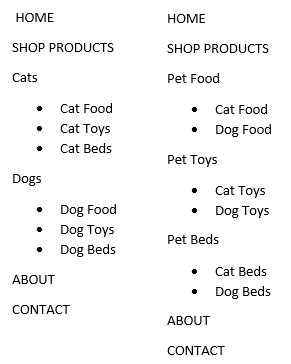
Can Your Sitemap Scale?
Both example outlines above will work. They start with broad categories and narrow them down. Just like an outline for a paper.
Categories in your outline translate into top-level pages on your website.
Keep the top-level pages as concise as possible. The titles of these pages will be shown in the header of your website. There may be additional elements in your website’s header, too.
In the example below, the header contains the business logo, navigation menu, search feature, and sign in link.
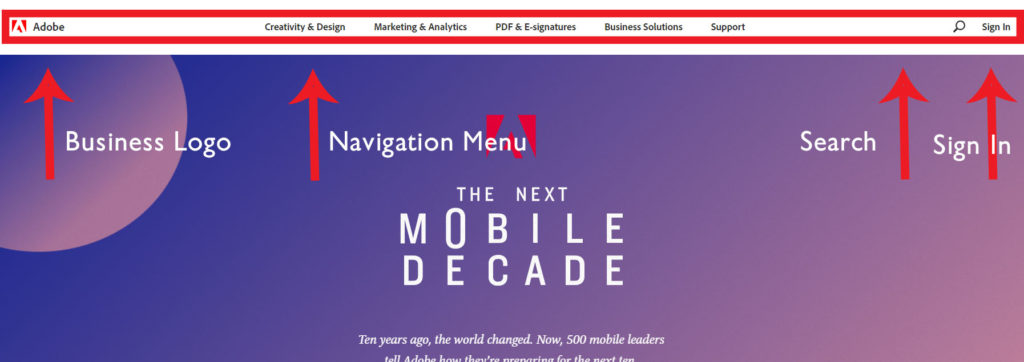
Adding additional elements to the header of your website can make the design less appealing. It may look cluttered to website visitors – and this could cause them to either not use the navigation menu or leave the website entirely.
The top-level pages will likely stay the same on your website until your business is ready to redesign it. So carefully consider these top-level pages.
Creating a Sitemap for Your Customers
Your website sitemap isn’t finished yet. We have the very basics of your website – Home, About, Services/Products, and Contact – now it’s time to add pages just for your target audience.
Common website pages geared to specific client/customer needs include FAQs (Frequently Asked Questions); Get a Quote; Customer Service; Case Studies; Customer Stories; etc.
User-Friendly Organization
Let’s consider a few different methods of organization for this section of your website outline.
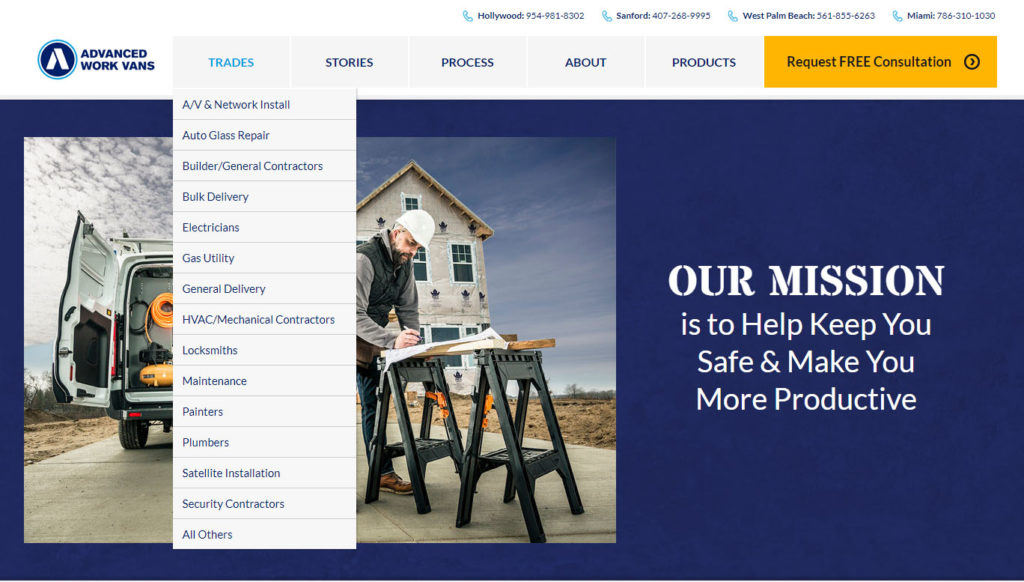
INDUSTRIES – List the industries you service (i.e. Medical, Manufacturing, & Aerospace).
In the website below, the page Trades expands to show a drop-down menu with multiple pages listed beneath it.

WEBSITE USERS – Some websites target client types instead of industries. If you’re an educational institution, your client types may include Students, Faculty, and Parents. If your institution is private, you may want to add Investors to your list.
The website below splits its homepage into two major sections: Health Care Professionals and Families. Because the information for these customer types is so different, it’s wise to separate the content at a very high level.
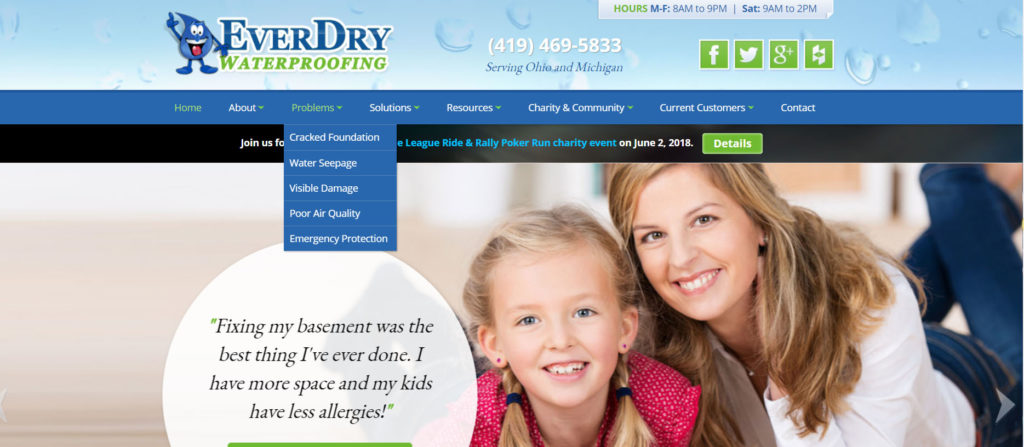
PROBLEMS SOLVED – Maybe your business wants to focus on solving problems for customers. If so, consider adding this section to your website outline. Examples may include Termite Infestation, Debt, or Emergency Babysitter.
The website below separates pages into Problems and, next to it, Solutions.
Creating a Website for Your Business: TRAFFIC
During the process of creating a website and getting ready for website launch, it’s necessary to question the sources of your future website traffic.
How will you get visitors to your website? Where will they come from?
Creating an Optimized Website for Your Business
The very first step to getting visitors to your website is to optimize the website for search engines like Google. If Google can’t find your website, it’s likely your customers won’t be able to find it online, either.
Search Engine Optimization (SEO) is a digital marketing term that encompasses a lot of technical items regarding a website. (If you’re new to SEO, you may be interested to read Inside the Mysterious World of SEO with Andy Smith.) SEO is the practice of helping Google find and rank your website online. Once Google finds your website, it will index it, a lot like a library indexes a book. Google uses its indexing system to determine how websites rank in the results.
If your website is well optimized for Google, Google will be able to understand the topic of your website, and the information on your webpages. This is how you create an optimized website. Optimized website links show up in Local Listings and Organic Results on Google.
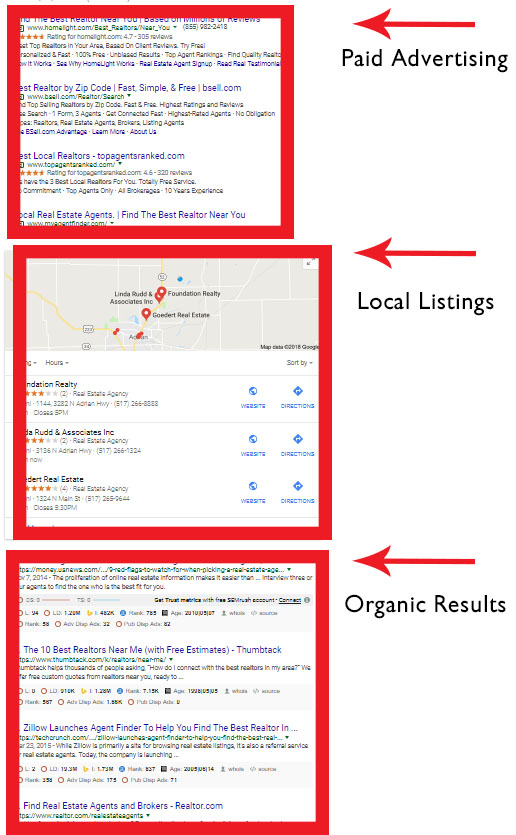
But we’re not done yet – Many business owners believe that once a website is built, the work of getting it online is done. It’s not.
You have to work for your rank in Google.
There are dozens of businesses that compete with you online. Every single one of those websites competes for the top ranks in Google. That’s a lot of online competition.
If your competition is focused on increasing Google rankings, you also need to focus on this, or your website will fall off the first page of Google for key terms you need to rank for.
Creating a Marketing-Centered Website for Your Business
The first step to getting visitors to your website is optimization for search engines.
The second step is to create a long-term strategy for marketing.
What type of digital marketing strategy will you use?
- Inbound Marketing
- Content Marketing
- Social Media Marketing
- Ongoing SEO
- Paid Advertising (Google AdWords)
Once you determine your marketing strategy at a high level, think about how your website influences your digital marketing strategy. Also think about how your digital marketing strategy impacts your website.
A top consideration is your website’s sitemap, as discussed earlier. Creating a website that evolves as your business evolves means planning for the evolution of your website. Much like the foundation of a house, your sitemap is the foundation – the structure – of your website. Plan for additions now.
Creating a Website for Your Business: MAINTENANCE & SUPPORT
Another consideration when creating a business website is ongoing website support and maintenance. A large business website or e-commerce store requires ongoing maintenance to function its best. Your website will also need to be regularly updated to keep it relevant.
Common Website Maintenance & Support Items
Here are a few of the technical items of a website that require maintenance:
- Hosting and Domain Name Renewal
- SSL Certificate (especially for e-commerce)
- Software Updates
You’ll also want to do the following:
- Add New Pages
- Edit Text
- Change Images
In addition, there are items that come up all the time on a business website. These are common items:
- Broken Links
- Form Submission Errors
- Shopping Cart Errors
- Browser Compatibility Issues
As your website lives online, you’ll run into your share of issues. What’s your plan for handling them? (You may want to read When Website Mistakes Happen, Where’s Your Support Team?) Many large businesses or e-commerce website need a development team to identify and fix issues it encounters.
Not all website issues need to be handled by a developer; you can learn to fix common website problems by yourself. Of course, it isn’t always about being able to do something – you may want to spend your time on tasks other than website fixes. That’s where your website support team comes into play.
Common Scenarios that Result in Website Changes
Websites require upkeep, like many things do. Here are a few scenarios that pop up in the life of a business website:
Employee Turnover – Employees don’t always stick around. When they leave, you’ll need to remove their photo and bio from the website.
Policy Changes – Business policies are updated all the time. For large websites, this may mean a review of many, many pages to ensure the policy is up to date across the board.
Brand Redesign – Savvy business owners understand how vital a brand is. If you update your brand – logo design, branding colors – you’ll need to update the look of your website to match the brand.
Marketing Campaigns – Many business websites have a large homepage banner image (or Hero Image) with a marketing message and call to action (CTA). This banner image, message, and CTA require updates multiple times a year for many businesses (especially e-commerce).
Google’s Algorithm – Changes to Google’s algorithm may mean changes to your website’s content or code.
AdWords Campaigns – If your business runs an AdWords campaign, you’ll need landing pages. Those landing pages must be planned, designed, coded, and launched online. Who will do that?
User Experience Tests – Large businesses and corporations routinely run UX tests to ensure visitors get the very best website experience. Testing the experience of your website may require the addition of heatmapping software or the creation of landing pages. Once testing is complete, the results will point to changes needed on your website.
There are so many items that come up for business and e-commerce websites. Most of the issues are minor, but changes still need to be made to your website. Plan for those changes, so that your business website can evolve elegantly.
Say Hello!
Give Artonic a call or email us if you’re interested in website design, development, or marketing.
Michigan, USA

